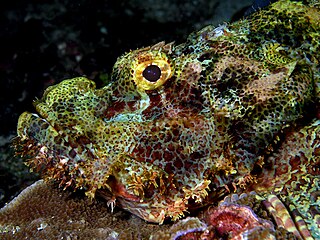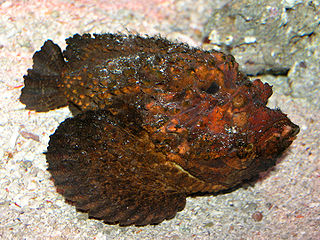
The Scorpaenidae are a family of mostly marine fish that includes many of the world's most venomous species. As their name suggests, scorpionfish have a type of "sting" in the form of sharp spines coated with venomous mucus. The family is a large one, with hundreds of members. They are widespread in tropical and temperate seas but mostly found in the Indo-Pacific. They should not be confused with the cabezones, of the genus Scorpaenichthys, which belong to a separate, though related, family, Cottidae.

Synanceiinae is a subfamily of venomous ray-finned fishes, waspfishes, which is classified as part of the family Scorpaenidae, the scorpionfishes and their relatives. These fishes are found in the Indo-Pacific oceans. They are primarily marine, though some species are known to live in fresh or brackish waters. The various species of this family are known informally as stonefish, stinger, stingfish and ghouls. Its species are known to have the most potent neurotoxins of all the fish venoms, secreted from glands at the base of their needle-like dorsal fin spines. The vernacular name, stonefish, for some of these fishes derives from their behaviour of camouflaging as rocks. The type species of the family is the estuarine stonefish.

Scorpaenodes is a widespread genus of marine ray-finned fish belonging to the family Scorpaenidae, the scorpionfishes. The fishes in this genus are found to the Atlantic, Indian and Pacific Ocean.

Dendrochirus is a genus of marine ray-finned fishes belonging to the family Scorpaenidae, the scorpionfishes. They are mostly known as turkeyfishes or pygmy lionfishes. They are native to the Indian and Pacific Oceans. They are also popular aquarium fish.

Brachypterois is a genus of marine ray-finned fishes belonging to the family Scorpaenidae, the scorpionfishes. They are native to the Indian Ocean and the western Pacific Ocean.
Phenacoscorpius, the no-lined scorpionfishes, is a genus of marine ray-finned fish belonging to the family Scorpaenidae, the scorpionfishes. They are native to the western Atlantic, Pacific and Indian oceans.

Neomerinthe is a genus of marine ray-finned fish belonging to the family Scorpaenidae, the scorpionfishes. They are found in Atlantic, Indian and Pacific Ocean.
The spotfin scorpionfish is a species of marine ray-finned fish belonging to the family Scorpaenidae, the scorpionfishes. It is known from the western Indian Ocean This species is the only known member of the genus Neoscorpanea.

Parapterois heterura, the blackfoot firefish, blackfoot firefish, blue-fin lionfish, black-Foot lionfish or gurnard lionfish, is a species of marine ray-finned fish belonging to the family Scorpaenidae, the scorpionfishes. It is widely distributed on the southeastern coast of Africa as well as off Japan and in Indonesia where it is usually found in sheltered coastal bays with a soft bottom, such as fine sand or mud. It is found in depths ranging from 40 to 300 metres. This species is a sedentary fish and may even bury itself within the substrate. P. heterura flashes its brightly colored pectoral fins to startle predators and escape, but it may also use these fins to corner prey. This behavior has been demonstrated in other lionfish. This species can be found in the aquarium trade.

Pteroidichthys amboinensis, the Ambon scorpionfish or Godfrey's scorpionfish, is a species of marine ray-finned fish belonging to the family Scorpaenidae, the scorpionfishes. It is found in the Indian and Pacific oceans.

Tetraroginae is a subfamily of marine ray-finned fishes, commonly known as waspfishes or sailback scorpionfishes, belonging to the family Scorpaenidae, the scorpionfishes and their relatives. These fishes are native to the Indian Ocean and the West Pacific. As their name suggests, waspfishes are often venomous; having poison glands on their spines. They are bottom-dwelling fish, living at depths to 300 metres (980 ft). These creatures usually live in hiding places on the sea bottom.

Inimicus is a genus of marine ray-finned fishes, it is one of two genera in the tribe Choridactylini, one of the three tribes which are classified within the subfamily Synanceiinae within the family Scorpaenidae, the scorpionfishes and their relatives. These venomous, benthic fishes are found on sandy or silty substrates of lagoon and seaward reefs, in coastal regions of tropical oceans. The ten described species are collectively known by various common names, including ghoul, goblinfish, sea goblin, spiny devilfish, stinger, and stingfish.

Plectrogenium, is a genus of marine ray-finned fishes, the stinger flatheads, the only genus classified within the subfamily Plectrogeninae, which in turn is classified within the family Scorpaenidae. This genus is found in the Indian and Pacific Oceans.

Choridactylus is a genus of marine ray-finned fishes, it is one of two genera in the tribe Choridactylini, one of the three tribes which are classified within the subfamily Synanceiinae within the family Scorpaenidae, the scorpionfishes and their relatives. They are commonly known as stingfishes. They are found in the Indo-West Pacific.
Leptosynanceia is a monotypic genus of ray-finned fish belonging to the subfamily Synanceiinae, the stonefishes, which is classified within the family Scorpaenidae, the scorpionfishes and relatives, its only species is Leptosynanceia asteroblepa which is called the mangrove stonefish in Malaysia. This species native to the brackish and fresh waters of Southeast Asia. This species grows to a total length of 23 centimetres (9.1 in). This species is an extremely dangerous fish whose venom can cause a human to die within 1 to 2 hours after contact. The pain caused by the venom is described as "agonizing".

The blackfin stonefish is a species of venomous ray-finned fish, a stonefish be longing to the subfamily Synanceiinae of the family Scorpaenidae, the scorpionfishes and their relatives. It is the only species in the monotypic genus. It is native to the western Indian Ocean where it occurs in areas with muddy bottoms. This species grows to a total length of 13 centimetres (5.1 in).

The stargazing stonefish is a species of stonefish native to the Indian Ocean and the western Pacific Ocean where it is found on muddy bottoms in estuaries. This venomous species is also a minor component of local commercial fisheries. This species grows to a length of 8 centimetres (3.1 in) SL. This species is the only known member of the genus Trachicephalus.

Pseudovespicula is a genus of venomous ray-finned fishes, waspfishes belonging to the subfamily Tetraroginae, which is classified as part of the family Scorpaenidae, the scorpionfishes and their relatives. It has been considered to be a monotypic genus, containing only the type species, Pseudovespicula dracaena, but some authorities classify three species within the genus. The genus is found in the Indo-Pacific region.

Minous monodactylus, the grey stingfish or grey goblinfish, is a species of marine ray-finned fishes, it is the only genus in the tribe Minoini, one of the three tribes which are classified within the subfamily Synanceiinae within the family Scorpaenidae, the scorpionfishes and their relatives. This species found in the Indo-Pacific and is venomous to humans.

Choridactylini, commonly known as stingfishes, stingers or ghouls, is a tribe of venomous ray-finned fishes classified within the subfamily Synanceiinae, the stonefishes, part of the family Scorpaenidae, the scorpionfishes and their relatives. These fishes are found in the Indo-Pacific.

















